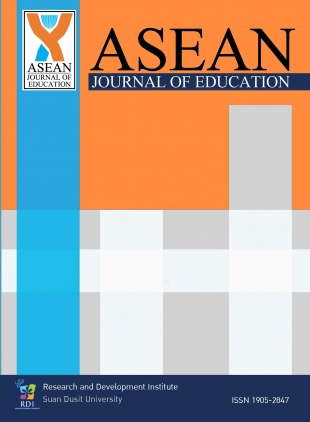Factor Analysis of Spirituality as Medical Teachers, Faculty of Medicine Siriraj Hospital, Mahidol University
Keywords:
Factor analysis, Spirituality, Medical teachersAbstract
The purpose of this study is to analyze factors of spirituality as medical teachers. The sample is 300 medical teachers, Faculty of Medicine Siriraj Hospital. The instrument is a questionnaire about the characteristics of spirituality as medical teachers and the content validity determined by 0.67 - 1.00 of IOC and 0.98 of the alpha coefficient reliability. The methods used for data analysis was an exploratory factor analysis (EFA) with the factor extraction that consisted of common factor analysis (CFA) using PAF and orthogonality by varimax method. The result of checking the relationship among the variables showed that 96 observable variables have KMO at 0.953 and communality (h2) is at 0.57 - 0.90. The results found 7 factors that show the spirituality as medical teachers; (1) Roles and Duties as a Medical Teacher, (2) Operating in an Integrity Profession, (3) Responsibility, (4) Innovation and Academic work, (5) Soulful of Faith in the Profession of Medical Teachers, (6) Consideration of Benefits for Work and Altruism and (7) Focus on self-development and journey to excellence. In particular, the obtained factors shows 63.81 percent of spirituality as medical teachers. In conclusion, the doctor who teaches "medical teacher" should have the spirit of being a teacher because the doctor is not only treating patients but also has to teach medical students to have knowledge, skills and attitudes so that they are able to treat patients effectively.
References
Angsuchoti, S., Vijitwanna, S., & Pinyophanuwat, R. (2009). Statistical analysis for social science and behavioral research: LISREL program technique. Bangkok: CharoenDeeManKong Printing Company.
Comrey, A. L., & Lee, H. B. (1992). A First course in factor analysis. (2nd ed). Hillsdale, New Jersey: Lawrence Erlbaum Associated.
Darbavasu, S. (2016). Strategies for developing teacher spirituality to enhance professional teacher of students in faculty of Education, Suan Sunandha Rajabhat University. Ratchaphruek Journal, 15(1), 1-10.
Gawain, S. (2000). The path of transformation: How healing ourselves can change the world. Novato, CA, USA: New World Library.
Janesawang, D., Yoelao, D., Singsuriya, P., & Chitcharas, N. (2012). Experience of spirituality in teachers: A phenomenological study. Journal of Behavioral Science, 18(1), 55-65.
Jirapinyo, P. (2010). Medical teacher and scientist. Siriraj Medical Bulletin. 3(2), 100-102.
Kaiyaiwan, Y. (2013). Multivariate statistical analysis for research. (1st ed). Bangkok: Chulalongkorn University Press.
Kaensan, A., Chalakbang, W., Phengsawat, W., & Steanoppakao, P. (2017). Developing indicators of spirituality of teachers under the office of the Basic Education Commission. Nakhon Phanom University Journal, 7(1), 1-15.
Mahidol University Faculty Senate. (2008). Professional ethics guide for teachers of Mahidol University Faculty Senate. Retrieved 2020, Febuary 10, from https://goo.gl/5oNFJf
Mitroff, I. I., & Denton, E. A. (1999). A study of spirituality in the workplace. MIT Sloan Management Review, 40(4), 83-92.
Office of the Basic Education Commission. (2012). The top teachers who had ideals: The trace of fame of teachers and teacher’s spirituality project in year 2011. Bangkok: Sassana Plublishing House.
Phanpinit, S. (2008). Research techniques in social science. (3rd ed.). Bangkok: Witthayaphat.
Phothiwat, K. (2011). Professional Teacher: A new hope. Retrieved 2020, Febuary 10, from https://www.thailis.or.th/tdc/browse
Raksamtham, S. (2010). The role of local universities and social responsibility, In case of flood disaster. Retrieved 2020, Febuary 10, from https://www.bangkokbiznews.com/home/detail/politics/opinion/reader-opinion/20101208/366374.html
Sangthaweesin, C. (2014). Basic medical education program. Retrieved from https://bit.ly/2tszlka
Sobkroo. (2015). Professional teacher vs teaching profession. Retrieved 2020, Febuary 10, from https://www.sobkroo.com
Somrung, P. (2013). The spirituality of the nursing leader - Florence Nightingale. Bangkok: Chulalongkorn University Printing House.
The Office of the National Education Commission. (1999). National Education Act 1999. Bangkok: Seven Printing.
The Quality Learning Foundation. (2014). Summary of the seminar on the promotion of Thai teachers in the 21st century, 18 March 2014.
The Secretariat of the Council of Education. (2009). State of teacher shortage Faculty and educational personnel and suggestions for solutions. Bangkok: Sweet chili graphic.
The Teachers Council of Thailand. (1997). Teacher ethics of the secretariat of the teachers council of Thailand. Retrieved 2020, Febuary 10, from https://www.goo.gl/7B6iPA
The Teacher Civil Service and Educational Personnel Commission. (2004). Good teachers who develop the Nation’s humankind resources (Details Ed.). Bangkok: Teacher Council of Thailand.
Udompetch, P. (2018). The experience of medical teachers having teachers’ spirituality. Retrieved 2020, Febuary 10, from https://www.rsucon.rsu.ac.th/proceeding/article/44
Vajayanon, P. (2010). Comments about the medical teacher. Siriraj Medical Bulletin, 3(1), 1-8.
Vajiramedhi, W. (2015). The spirituality of teachers. Retrieved 2020, Febuary 10, from https://www.gotoknow.org/post/329230
Downloads
Published
How to Cite
Issue
Section
License

This work is licensed under a Creative Commons Attribution-NonCommercial-NoDerivatives 4.0 International License.
1 All articles will undergo a formal peer-review. A panel of experts from within or without the university will examine the article; approval from a minimum of two experts is required for publication. Revisions posed by the experts must be completed by the research prior to publication.
2 Once published in the ASEAN Journal of Education, the article becomes intellectual property of Suan Dusit University. Duplication, in full or part, requires permission from Suan Dusit University.
3 Excluding errors incurred during printing, author(s) are responsible for the content of their articles.






